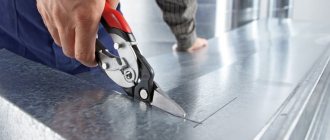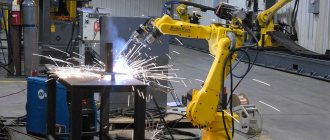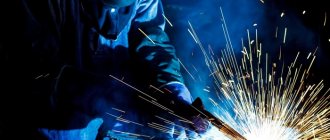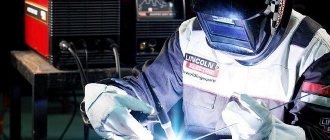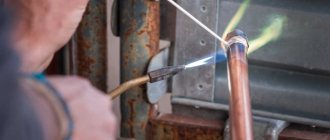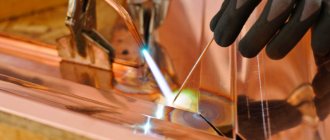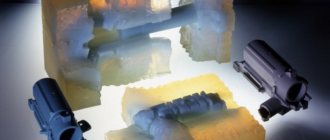Home>>Welding methods>>Automatic welding>>Automatic submerged arc welding
Automatic submerged arc welding is a type of arc welding in which an electric arc burns under a layer of welding flux, which prevents the penetration of atmospheric air into the welding zone. On this page we will look at the essence of automatic submerged arc welding.
Flux not only protects the welding zone from environmental influences, it also helps to stabilize the electric arc, promotes deoxidation of the metal, and ensures alloying of the metal being welded with the necessary chemical elements, thus improving the weldability of the metal and ensuring high mechanical properties of the weld.
What it is?
Most metals, when interacting with atmospheric oxygen, are quickly covered with a thin layer of oxide. On the one hand, it even provides some protective function, preventing corrosion of the internal layers of the metal, but for welding, the oxide poses a big problem because it does not allow direct access to the metal product.
The oxide layer re-forms quite quickly, so welding metal without any protection of the surface from oxygen is unproductive. This or that composition that coats the working surface is called welding flux - it can consist of various components and can often destroy the already formed oxide.
At least fifty types of fluxes are known, however, such diversity does not mean that you can take any of them - each has specific features. All existing brands have clear requirements specified in GOST 9087-81. The essence of submerged arc welding as a process is that the electric arc burns under the flux mixture, and not just where we see it. Arc burning is possible due to the supply of high voltage to the electrode wire. A cloud of gases forms around the arc, formed during the melting of both the flux and the metal itself.
The welding itself and the connections created with its help are described by another GOST - 8713-19.
This is interesting: Features of galvanizing steel using the Sendzimir method
Effect of protective coating
Electric arc welding under a layer of protective powder is a simple, but high-quality and reliable connection of various metal structures and parts.
The peculiarity of submerged arc welding lies in the connection of molten metal of two parts under a layer of special granular powder. At high temperatures of the electric arc, the metal and flux melt.
The film formed when the granules melt protects the weld pool from exposure to oxygen and the environment and prevents metal from splashing.
A thin layer of slag appears on the seam, which allows the welded joint to cool evenly. The crust is easily removed from the surface of the seam. It is necessary to perform removal for visual control of welding quality.
To remove slag, just hit it lightly with a hammer and it will crumble. Before this, it is necessary to remove the remaining flux from the parts; it can be used at the next joint.
Characteristics of welding in a protective environment
The parts must be properly prepared for connection:
- clean from dirt, traces of corrosion and old paint;
- process with a grinding wheel or wire brush.
The technology is simplified through the use of machines. The master does not light the arc and does not monitor its combustion. The wire feed speed is controlled by the unit. It is up to the individual to set up the equipment correctly. For each welding mode it is individual, requiring special calculations.
During operation, filler wire is often used. It is loaded into the machine and supplied automatically. It is better to choose a composition similar to the metal being welded.
The flux is first poured into a container, then it covers the metal in an even layer at the junction of the workpieces. Under the influence of the high temperature of the arc, it melts, forming a small cloud of inert gas that protects the seam from oxygen entering it. After cooling, the burnt flux turns into slag, which is removed by the welder.
Welding process
When parts are welded using flux, the arc burns using the original granular powder. The high temperature causes the electrode and surrounding granules to melt. As a result, an elastic film appears that surrounds the welding area .
The film blocks the access of oxygen to the welding arc. The seam is obtained without cracks or cavities. After cooling, the flux turns into slag, uniformly covering the seam. When the operation is completed, the hard crust is removed mechanically. The remaining flux is used for further operations. This “loose blanket” is suitable for work on various equipment.
Types of fluxes and their features
According to the manufacturing method, fluxes are:
- fused;
- ceramic.
Fused fluxes are made from slag-forming manganese ores and quartz sand by grinding, mixing and melting, followed by granulation. Such fluxes are economical and well suited for welding low-alloy steel parts.
Ceramic (unmelted) fluxes are made from oxidizing agents and salts of amphoteric metals, which are crushed, mixed with liquid glass until homogeneous, then granulated and calcined.
Approximate cost of ceramic fluxes on Yandex.market
Ceramic fluxes have a fine powder structure; they are used for welding complex high-alloy steel alloys, and the composition of the flux is selected for the specific grade of steel being welded.
According to the chemical composition, fluxes are:
- saline;
- oxide;
- mixed.
Salt fluxes contain fluoride and chloride salts and are used for electric welding of titanium and steel alloyed with nickel and chromium. Oxide fluxes contain oxides of active metals and silicon and are used for welding low-carbon steel. Mixed fluxes contain metal oxides and salts in various proportions and are used for welding multicomponent alloys or parts made of different metals.
Conditions for using welding fluxes
The purpose of the flux is to stabilize metallurgical processes while maintaining the required productivity of the electrodes. To do this, certain conditions must be observed during the welding process.
- The flux should not react chemically with the metal of the rod and the base metal.
- The weld pool area must remain isolated throughout the welding process.
Residues of flux associated with the slag crust as a result of welding should be easily removed upon completion of work. Moreover, up to 80% of the material can be reused after cleaning.
Description of process technology
There are three main methods of submerged arc welding:
- auto;
- semi-automatic;
- manual.
In automatic welding, the trajectory and speed of the electrode, as well as the wire feed speed, are regulated by the control processor; workers participate only as process controllers for emergency shutdown of the welding unit.
Semi-automatic submerged arc welding assumes that the wire feed speed, welding current and the angle of the electrode to the welding line are adjusted automatically, and the arc is controlled manually by the welder - through a handle or remote control. The semi-automatic welding unit allows you to manually change individual current parameters directly during the welding process.
Manual submerged arc welding is used in small units, where the flux supply system is built into a non-consumable electrode, while the welder adjusts the direction of movement, the angle of inclination and the speed of the electrode in manual mode, using special buttons to control the flux supply and welding current.
General procedure for submerged arc welding:
- The oxide film is removed from the surfaces of parts.
- Parts are fixed on the welding plate.
- Selecting settings and mode of the welding machine.
- The flux tank is being filled.
- A coil of floating wire is installed , the end of which is tucked into the electrode.
- The welding process takes place.
- After the parts have cooled, unused flux is collected and the seam is cleaned of slag.
It is important to monitor the consumption of wire and flux to prevent the electrode from running idle and damaging parts.
Application area
It is necessary to understand where submerged arc welding is used, which is rightfully considered one of the main methods for obtaining a permanent connection. Welding is performed in the lower position, for connecting parts end-to-end, overlapping, for corner connection methods.
Previously, the method was used only for welding metal structures made of structural steels. With the development of new technologies, it became possible to weld all types of steel and nickel alloys. For this purpose, a wire suitable in its composition is used.
Titanium and its alloys, copper and copper-based alloys, aluminum alloys and pure metal - these materials are successfully and reliably joined using submerged arc welding.
Using the submerged arc method, complex building structures, bridges, pipes, tanks, sea and river vessels are welded. It is economically profitable to use this method for sheets with a thickness of 6 mm or more.
It is important to choose the right operating mode, wire material and type of flux . The seam will be able to withstand large temperature changes and exposure to aggressive environments. A joint made by a professional will withstand very high pressure and will be reliable in conditions of complete vacuum.
Necessary equipment
The connection of parts must occur with stationary workpieces. For this purpose, mobile type heads are sometimes used. The industry produces both special units for automatic welding and semi-automatic machines that operate under a layer of flux.
Wire is used with a diameter of up to 3 mm. It is supplied automatically.
Some models of devices are equipped with a mechanism for collecting flux that does not melt. There is a device for monitoring seam parameters. Devices equipped with a laser independently monitor the position of the welding electrode. The screen is installed at a distance of up to 20 m from the self-propelled tractor.
This is interesting: Hot metal stamping: the essence and advantages of the technology
Welding equipment
For flux welding, stationary conditions and equipment will be required:
- welding plate;
- fused wire;
- non-consumable electrode;
- flux supply system;
- control system.
Welding plates are made on a concrete base made of heat-resistant materials with the possibility of fastening parts. The wire is taken from the material of the parts being welded, thickness from 0.3 to 12 mm. The electrode is made of tungsten alloy with ceramic braid.
The flux supply system consists of a reservoir and a hose, the end of which is 10-30 cm from the electrode. The diameter of the flux supply hose should allow granules to flow freely in front of the electrode.
Automatic submerged arc welding process diagram
Automatic and semi-automatic submerged arc welding is controlled by software that regulates the direction and speed of movement of the electrode along the welding line.
We select everything you need
Submerged arc welding will show its best side only if you select everything necessary for it as correctly as possible. This statement applies to both equipment and flux compositions.
Equipment
automatic assembly-type stand is most often used , which allows not only to weld any structures, but also to securely fix them in the position in which they will have to remain permanently after completion of the work. Such equipment is distinguished by increased reliability of fastening elements - this makes it possible to guarantee that there are no deviations in the seams or the shape of the future product, especially since the master does not see the seam during the work process.
This unit is convenient for making butt and fillet welds, works quickly, and ensures high quality and reliability of connections. The design controls itself, which is why it is expensive - as an alternative, mobile heads are sometimes installed on the stand.
A semi-automatic machine costs significantly less, but requires much greater involvement from the operator in the process. The direction of the wire and control of the stick out of the electrode are entirely transferred to the shoulders of the welder, although the wire feed is still done automatically. Voltage power, speed of movement along the seam and angle of inclination of the electrode are the parameters of the welding mode that the master must choose independently, depending on the specifics of the workpiece.
Manual equipment is more often used in small workshops or by hobbyists, although there are specific areas of application where this is the most convenient option for completing the task. Thus, manual welding is possible even in hard-to-reach places and in any position.
Such equipment is relatively inexpensive, so it is widely used by non-professionals.
Fluxes
Welding fluxes come in various types, their marking is strictly tied to the current GOST. Classification of such compositions is possible according to various criteria; we will consider only a few of them. First of all, all fluxes are divided into classes depending on the material for which they are suitable for welding . High-alloy steel requires one class of composition, while carbon or alloy steel requires another. The third, separate class of fluxes is produced by manufacturers specifically for non-ferrous metals and alloys - copper, bronze, and so on.
Based on the production method, fluxes are divided into ceramic and fused. Ceramic ones are good because they provide improved weld quality and have alloying properties. The mass is produced by extruding bulk ceramic components followed by the addition of liquid glass. Fused fluxes have a structure reminiscent of pumice or glass and are produced by melting and sintering ingredients to form granules.
There is also a classification of fluxes according to their chemical composition. The following classes are distinguished.
- Salt compounds consist of chlorides and fluorides. A typical area of their application is the boiling of active metals and slag remelting.
- Oxide mixtures are metal oxides with some admixture of fluorine compounds. This is the optimal choice for welding fluorine and low-alloy steels.
- Mixed fluxes , as the name suggests, are a combination of salt and oxide fluxes. This substance is best suited for welding alloy steels.
Flux mixtures are also classified according to the form in which they are sold. Granules and powder are the most common forms of flux, but only if the welding is to be electric. The composition can take the form of a paste or even a gas, but then it is intended for less frequent gas welding. Some novice welders, out of habit, also strive to determine the best flux manufacturer, traditionally giving preference to compositions of imported brands.
In fact, when choosing a flux, this is the very last factor that you should pay attention to - it is much more important to choose the right mixture according to all other criteria.
Why do you need flux when welding?
The use of fluxes provides the following advantages in welding.
- In both electric arc and gas welding, the welding flux provides more intense melting of the metal (at high currents or high oxygen concentrations, respectively). Thanks to this, there is no need to cut the edges of the future weld in advance.
- In the weld area and on the surfaces adjacent to it, it is possible to avoid metal waste - its losses due to oxidation and evaporation .
- Arc burning has higher stability , which is especially important for complex seam configurations
- Energy losses of the current source for heating the metal are reduced, and its efficiency increases accordingly.
- The consumption of filler material is optimized .
- More convenient work for the welder, because the flux shields some of the arc flame.
Pros and cons of the method
Many people are interested in submerged arc welding - what it is, what are the positive and negative aspects of this method. There are many advantages:
- possibility of process automation;
- obtaining high-quality connections without a highly qualified technician;
- high speed of operations.
Flaws:
- You can only cook with a horizontal seam;
- workpieces must be precisely adjusted;
- metal must be carefully prepared for work;
- high cost of equipment and components.
The listed advantages make it possible to use the mechanical method in many areas of industry. For example, in shipbuilding, in the manufacture of tanks for oil workers, and in the welding of large-diameter pipes on gas pipelines.
Advantages of flux welding
The emergence of the technological process of welding using flux can be compared with a revolution in the industrial sector.
This technology was first used to process low-carbon steel. Today, this powder is used for welding absolutely any, even very refractory metals that are difficult to weld.
Mechanized equipment and various semi-automatic systems allow the use of flux for various operations:
- Formation of a vertical seam. Welding sheet metal with a thickness of 20-30 mm is considered the most durable.
- Pipe connection. The machines initially welded small-diameter pipes. Today, after improvements in technology, it has become possible to process large diameter products.
- Obtaining a circular seam. The welding process is complicated by holding the weld pool while preventing the metal from spreading. This welding is performed on machines equipped with CNC (Computer Numerical Control). Sometimes additional manual welding is carried out.
Modes
The choice of welding mode depends on various indicators, for example, the method of cutting the edges, their thickness, the planned number of passes along the future seam and the method of holding the weld pool. Current strength and voltage, wire cross-section diameter, welding speed, position of the product itself and electrode extension also influence the choice of workpiece processing tactics. Parameters for each workpiece are always calculated individually.
For example, for the most common welding of butt seams, one one-sided pass under submerged arc is enough, provided that the thickness of the workpiece does not exceed 3 cm. If the parts are thicker, the seam is welded on both sides and additional passes can be added. One-sided welding is relevant only in cases where the material is not afraid of overheating, and the seams should not give welding cracks.
If the sheets being welded are very thin (no thicker than 6 mm), cutting the edges as a stage of preparation for further processing is not performed, and the parts to be joined are placed as close to each other as possible, trying to minimize the gap to the limit. When the thickness of the workpiece is about 1-1.2 cm, on the contrary, a gap is left - this will help achieve improved quality of the seam and at the same time reduce the excess of molten metal. In any of the described cases, special fixation of the parts is required - either with a lining, or a welding seam, or preliminary assembly “into a lock.”
The lining is the most popular solution for welding metal sheets no more than 1 cm thick. As a rule, it is steel, 3-6 mm thick and 3-5 cm wide. Lock welding is used to connect important parts where burning through the material is unacceptable. It is also the best method for joining large and heavy structures. As for the back weld, this is a relatively rare welding mode, which is appropriate only if re-edging of the product is not realistic.
State regulation of technology, connection types, characteristics
GOST 8713-79 classifies and marks with letter designations the subtypes of the submerged arc joining method:
- AF - on weight . Produced without means to prevent metal from leaking into the gaps between the edges being joined. If you need to weld to full depth, then this is done in two steps on both sides of the seam.
- AFf - on a flux bed . The name of the method illustrates the essence: flux is placed under the joint to be welded, and a rubberized hose is pressed against the joint through a fireproof lining. Air is supplied into the tube under pressure - the powder is pressed tightly against the products in the seam area.
- AFm – on a flux-copper lining . It is used to prevent burnout of metal edges, connecting corner, butt and T-joints with flux-copper backings that form the reverse side of the seam.
- AFo – on the remaining lining . It is used for one-sided welding, when it is impossible to weld on a flux pad. Steel backings guarantee complete weld penetration of the seams.
- AFP – on a copper slider . Its design provides a cored wire connection with forced formation of a fillet weld. Liquid slag is formed as the arc burns and then floats to the surface.
- AFsh - with preliminary application of a welding seam . It is used less frequently due to significant labor costs. Simplifies the product assembly process.
- AFk - with preliminary welding of the weld root . Performed with a coated or consumable electrode in a protective gas. The penetration depth reaches 1/3 of the thickness of the part.
Possible problems
Even despite strictly following the instructions, a beginner may encounter some problems, the cause of which is unknown to him. The most striking example is the appearance of pores on the seam, indicating that there was gas under the flux that should not have been there. In most cases, porosity is caused by the presence of hydrogen or carbon dioxide, less often the root of evil is nitrogen. Nitrogen pores are only possible when working with micro-alloyed steel if the material has nitride hardening.
The same problem occurs if the workpiece was cut with a plasma cutter. Carbon dioxide falls under the flux if there are not enough deoxidizing agents in the weld pool. To prevent the formation of pores, at least 0.2% silicon is added to the liquid bath. Also, the deoxidation reaction occurs when the temperature decreases, and vice versa - there will be more carbon dioxide when it increases. The most common root cause of pores is hydrogen, often caused by insufficient cleaning of the edges to remove dirt or rust.
In addition, wet flux may be the source of hydrogen pores in the welded seam.
In the next video you will see automatic submerged arc welding of an I-beam at a factory.
Welding mode selection
Depending on the thickness and metal of the parts being welded, the submerged arc welding mode is selected. Each mode has its own range of voltage, welding current and wire diameter. The speed of seam formation ranges from 6 to 100 meters per hour.
If the thickness of the parts to be welded is from 2 to 10 mm, then the welding mode is selected on a steel lining under the joint of the parts. The flux bed mode is suitable for welding parts with a thickness of 10-25 mm, and welding of parts with a thickness of 16-70 mm is performed in the mode of preliminary manual welding of the lower part of the seam.
With an increase in the thickness of the parts being welded, the diameter of the wire electrode and the welding current increase, but the speed of formation of the weld decreases.
The welding current (A) depends on the wire thickness (mm) as follows:
- 2 mm – 200-400 A;
- 3 mm – 300-600 A;
- 4 mm – 400-800 A;
- 5 mm – 700-1000 A;
- 6 mm – 700-1200 A.
The welding voltage increases significantly only when the thickness of the parts is over 25 mm.
Features of submerged arc welding
Do not think that submerged arc welding is some completely new welding method. It was invented a long time ago, at the end of the 19th century, and the essence lies in the same use of filler wire and non-consumable electrodes. However, the equipment has constantly improved, and instead of gas covering the entire weld area, only flux is used. It has a powdery consistency and is poured over the seam.
Such a composition, under the influence of high temperatures, also begins to release gas, which will protect the parts being welded from oxides. When the powder burns out, only easily removable slag will remain, and if the product is not completely used, it can easily be saved until next time.
Before you do submerged arc cooking, you will need to select:
- mode;
- electrodes;
- filler wire.
Just like with any other welding work, you will need to properly shape the edges and degrease the parts. But here it will also be important to choose a flux, since it exists in different forms.
Flux protects the weld from oxides
Materials used
The quality of welding depends on the correct choice of electrode wire. The chemical composition of the wire determines the suture characteristics. It is advisable to use steel wire that complies with GOST 2246-70. It is made from alloy, high-alloy, low-carbon steel. The dimensions of the finished wire correspond to the standard (diameter is 0.3-12 millimeters).
Wire is usually supplied in eighty-meter coils. Sometimes, with the buyer's permission, cassettes and reels are used. Before using wire that has been stored in a warehouse for a certain period, experts recommend cleaning it and treating it with gasoline/kerosene. This makes it possible to remove rust and dirt from it.
To connect aluminum parts, wire is used that complies with GOST 7871-75. Copper-coated wire is often used. It does not need to be pre-processed. The quality of welding performed with flux-cored wire without gas directly depends on the characteristics of the flux. The characteristics of the gaseous medium and liquid slag depend on the composition of the flux. Interacting with the part, the slag determines the structure of the weld metal. The resistance of the product to cracking depends on its structure.
Flux is used to:
- alloy seam metal;
- isolate the weld pool from external influences;
- create a suture surface;
- stabilize the arc discharge.
Areas of application
Fluxes are used for both manual and automatic arc welding to protect the surface being processed from unnecessary oxide formation, metal waste and to improve the quality of the resulting weld. At the same time, the specifics of using flux for different needs are somewhat different.
When manual welding, the part to be welded is usually coated with a layer of flux powder approximately half a centimeter thick. Saving on consumables, even though they are expensive, is unwise - a thin layer of flux can lead to low-quality welding and subsequent formation of cracks. Flux should be added as the electrode moves across the workpiece.
The industrial method is slightly different: if you cook using a semi-automatic or automatic method, then the flux will be supplied to the cooking site through a special tube. It is difficult to overdo it with the amount of flux powder in such a situation, because the unit includes pneumatic suction of excess powder.
The flux that is really needed for the job turns into a slag layer, which is removed after the job is completed.
The role of flux
With automatic welding everything is clear. But what about flux? What it is?
Flux is a special substance (can be produced in the form of powder, granules, pastes and liquids) with positive properties. Fluxes are fed in a thick layer directly into the welding zone, protecting it from the negative effects of oxygen. Flux also protects the metal itself, promotes stable arc burning, reduces the likelihood of metal spattering, and even changes the chemical composition of the weld if necessary.
Advantages and disadvantages
The advantages of submerged arc welding include:
- high degree of process automation;
- possibility of welding under high current intensity;
- high welding speed;
- high-quality seam without oxides and holes;
- possibility of increasing the weld pool for better weld penetration.
Automatic flux supply systems and maintaining a constant distance from the electrode to the seam allow you to weld complex parts with minimal participation of workers. The protective layer of flux prevents the molten metal from splashing, which allows welding at high currents, greatly increasing the speed of formation and quality of the weld.
The uniformity of the seam is achieved by isolating the weld pool from atmospheric oxygen, as well as by alloying the seam with flux components, which can be selected specifically for the material of the parts being welded. Also, submerged arc welding makes it possible to use two electrodes simultaneously, located at a distance of 10-20 mm from each other and powered by one current source - this allows you to make a larger submerged arc weld pool, thus increasing the welding speed and the degree of homogeneity of the finished product.
Disadvantages of submerged arc welding include difficulties in process control and technological complexity. Submerged arc welding units occupy large areas and require maintenance by qualified personnel. The weld is formed under a layer of flux and the welder does not have the ability to control the quality of the weld in real time. Defects can be avoided by adding ultrasonic or laser defect monitoring systems to the unit.
Features and Benefits
The advantages of semi-automatic and automatic welding under a protective layer of flux allow this type of permanent connection to occupy one of the leading places.
High level of performance
According to this characteristic, the advantage over manual welding is at least 6 times, some experts believe that it is much more. But this is not the limit; by increasing the operating coefficient of the welding machine, the amount of labor productivity increases. Another reason for achieving such results is the use of high current values during welding.
A dense layer of flux material does not allow the metal to spread, while good weld formation occurs. At higher current values, this equipment can reliably provide penetration of even thick metal without extensive cutting of edges. Therefore, productivity increases even more. The time required to clean up splashes and heavy metal spreading is reduced.
Improved seam quality
The quality of the connection increases due to the fact that the molten metal is not exposed to oxygen and other atmospheric substances.
There is a wide choice of welding wire material available. By using the brand that is best suited for welding, you can obtain a weld with a homogeneous composition.
It becomes possible to give the seam an excellent shape, with the required seam leg. Thanks to the protective film that forms when the flux burns, there are no undercuts, lack of penetration, pores or cracks in the seams. Finally, there is no need to replace electrodes, so the seam is smooth and without tears.
Economical consumption of materials and improved working conditions for the welder
When welding with submerged arcs, wire consumption is reduced by up to 35%, when compared with welding with electrodes. The material is not wasted in the form of cinders and metal spattering.
With this method, carbon monoxide is released in smaller quantities; the specialist’s eyes and face are not exposed to strong ultraviolet radiation, as with electric welding.
Welded joints - as defined by the state standard
According to GOST 8713-79, welds are classified as:
- butt;
- corner;
- T-bar;
- overlap.
In turn, they are divided into compounds:
- with flanged edge;
- without bevel;
- with bevel of one edge;
- with a curved bevel of one edge;
- with a broken bevel of one edge;
- with two symmetrical bevels on one edge.
